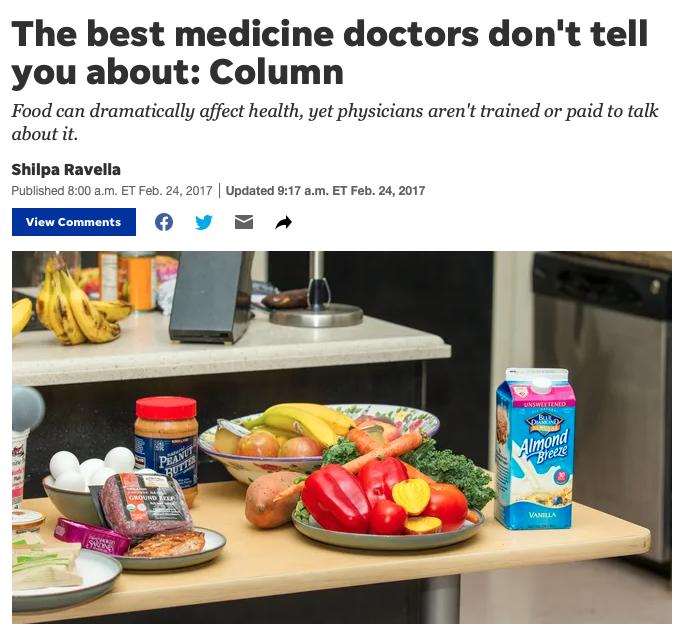February 24, 2017
By Shilpa Ravella
Food choices are the most important cause of poor health in the United States. Seven out of ten deaths are caused by chronic diseases like cancer, type 2 diabetes and heart disease, which can be prevented or treated with diet and account for 86% of the $2 trillion spent on U.S. health care every year. But food-as-medicine is still fringe medicine, a practice more likely to be found at a few specialized clinics rather than in the halls of academic medical institutions.
Only 14% of doctors feel qualified to talk to patients about food. The American Heart Association recently issued a scientific statement calling for improved nutrition training for doctors. But education is only a part of the problem — financial incentives also keep food out of medicine.
In academic research, whole foods get less money and attention than drugs even though studies show that food can dramatically affect health. Because there is no intellectual property involved in prescribing food, companies are not interested in funding scientists to study it. And in contrast to drug research, nutrition research is harder to conduct and interpret, making it more confusing and easy to ignore. Modern evidence-based medicine calls for high quality studies, known as randomized controlled trials (RCTs), to back up new treatments. Interest in RCTs grew by the mid-20th century, as the pharmaceutical industry allied with medical establishments.
While RCTs are great for evaluating drugs, they’re less useful for studying diet. Observational studies and other types of evidence are more practical for looking at food, but they’re easier to criticize due to design limitations. The research we have to date, including many observational studies and some RCTs, tells us we should be eating real, unprocessed foods, and mostly plants: fruits, vegetables, legumes, nuts, seeds and whole grains. That’s not new information, but in a country where most calories are obtained from processed foods and confusion about what to eat is rife, it can produce sensational results.
Research findings on food are not routinely incorporated into patient care. In clinical practice, prescribing food is poorly compensated, labor-intensive and may require new infrastructures. Patients want to hear about food from their doctors, but less than a quarter of doctors talk about diet. Unlike prescribing medications, changing food habits involves more extensive patient education. And the results are less immediate, which can be discouraging.
But studies have shown that spending even a few minutes talking about food in clinic visits can make a big impact on patients’ health. Many physicians, burdened with increasing paperwork and less time in clinics, may find this hard to do. New models of nutrition-centered care can incorporate support staff trained to help patients eat well, fostering a medical culture that focuses as much on lifestyle modifications as it does on drug therapy.
Doctors learn early on that it doesn’t pay to talk about food in medicine. Medical students in the U.S. get less than 20 hours of nutrition education over four years. More importantly, the teaching has little clinical relevance for the type of preventative healthcare badly needed in the U.S., where nearly 70% of adults are overweight or obese.
The basic structure of medical education was put in place in the 1920s, long before lifestyle-related chronic disease was a major public health focus. Coursework typically includes the biochemistry of nutrients and rare nutritional deficiency states, but not what types of foods we should be eating to stay healthy. After medical school, most physicians do not receive further training in nutrition.
Financial incentives to improve food choices are misaligned in medicine. But the cost of keeping food on the fringes of mainstream medicine continues to skyrocket and opens the door for confusion. Fad diets, media hype over studies with marginal relevance, and successful lobbying by Big Food to influence health and agricultural policies all skew the message patients and the public should hear.
Today, obesity is the most common reason nearly 4 out of 5 military recruits in the U.S. are rejected. By 2025, nearly half of Americans will have at least one chronic disease. Health care professionals are in a unique position to catalyze the routine, systematic implementation of food-as-medicine in medical education and clinical practice, a step that can drastically improve patient outcomes and move us toward public policies aligned with our health objectives (from USA Today).


